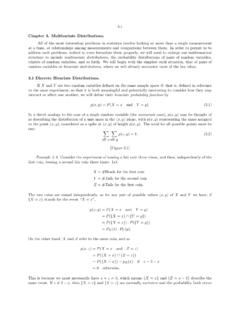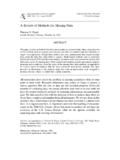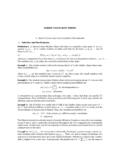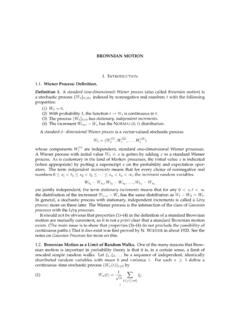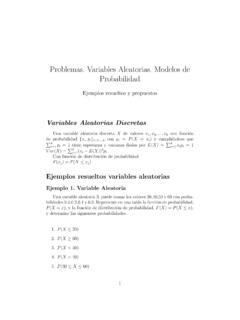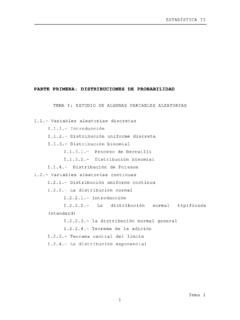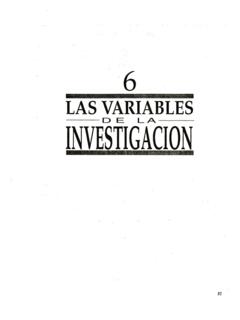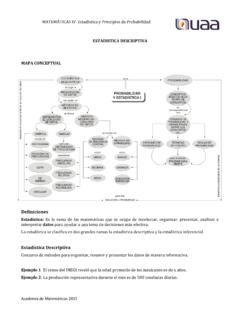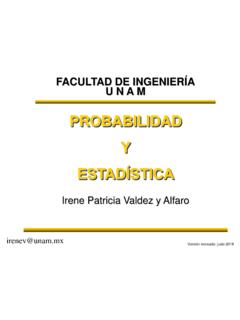Transcription of Brownian Motion - University of Chicago
1 Brownian Motion1 Brownian Motion : existence and first Definition of the Wiener processAccording to theDe Moivre-Laplacetheorem (the first and simplest case of the cen-tral limit theorem), the standard normal distribution arises as the limit of scaledand centered Binomial distributions, in the following sense. Let 1, 2,..be inde-pendent, identically distributedRademacherrandom variables, that is, independentrandom variables with distributionP{ i= +1}=P{ i= 1}=12,(1)and for eachn= 0,1,2,..letSn= ni=1 i. The discrete-time stochastic process{Sn}n 0is thesimple random walkon the integers. The De Moivre-Laplace theoremstates that for eachx R,limn P{Sn/ n x}= (x) := x 1(y)dywhere(2) t(y) =1 2 te y2/2t(3)is the normal (Gaussian) density with mean0and De Moivre-Laplace theorem has an important corollary: the family{ t}t 0of normal densities is closed under convolution.
2 To see this, observe that for any0< t <1the sumSn=S[nt]+ (Sn S[nt])is obtained by adding two independentRademacher sums; the De Moivre-Laplace theorem applies to each sum separately,and so by an elementary scaling we must have 1= t 1 t. More generally, foranys,t 0, s t= s+t.(4)This law can, of course, be proved without reference to the central limit theo-rem, either by direct calculation ( completing the square ) or by Fourier , our argument suggests a dynamical interpretation of the equation(4)that the more direct proofs obscure. For any finite set of times0 =t0< t1< <tm< there exist (on some probability space) independent, mean-zero Gaussianrandom variablesWti+1 Wtiwith variancesti+1 ti. The De Moivre-Laplacetheorem implies that asn ,1 n(S[nt1],S[nt2],..,S[ntm])D (Wt1,Wt2,..,Wtm).(5)The convolution law(4)guarantees that the joint distributions of these limiting ran-dom vectors are mutually consistent, that is, if the set of times{ti}i mis enlargedby adding more time points, the joint distribution ofWt1,Wt2.
3 ,Wtmwill not bechanged. This suggests the possibility of defining a continuous-time stochastic pro-cess{Wt}t 0in which all of the random vectors(Wt1,Wt2,..,Wtm)are (one-dimensional) Wiener process(also calledBrownian mo-tion) is a continuous-time stochastic process{Wt}t 0( , a family of real randomvariables indexed by the set of nonnegative real numberst) with the followingproperties:(A)W0= 0.(B) With probability1, the functiont Wtis continuous int.(C) The process{Wt}t 0hasstationary, independent increments.(D) For eachtthe random variableWthas the NORMAL(0,t) continuous-time stochastic process{Xt}t 0is said to haveindependent incrementsif for all0 t0< t1< < tmthe random variables(Xti+1 Xti)are mutuallyindependent; it is said to havestationary incrementsif for anys,t 0the distributionofXt+s Xsis the same as that ofXt X0.
4 Processes with stationary, independentincrements are known asL vy (C) and (D) are mutually consistent, by the convolution law(4), butit is by no means clear that there exists a stochastic process satisfying (C) and (D)that has continuous sample paths. That such a processdoesexist was first provedby N. WIENERin about 1.(Wiener)On any probability space( ,F,P)that supports an infinite se-quence of independent, identically distributed Normal (0,1)random variables there existsa standard Brownian will give at least one proof, due toP. L VY, later in the course. L vy s proofshows that exhibits the Wiener process as the sum of an almost surely uniformlyconvergent series. L vy s construction, like that of Wiener, gives some insight intothe mathematical structure of theorem Wiener process but obscures the connectionwith random walk.
5 There is another approach, however, that makes direct use2of the central limit theorem(5). Unfortunately, this approach requires a bit moretechnology (specifically, weak convergence theory for measures on metric space;see he bookWeak Convergence of Probability Measuresby P. Billingsley for details)than we have time for in this course. However, it has the advantage that it alsoexplains, at least in part, why the Wiener process is useful in the modeling of naturalprocesses. Many stochastic processes behave, at least for long stretches of time, likerandom walks with small but frequent jumps. The weak convergence theory showsthat such processes will look, at least approximately, and on the appropriate timescale, like Brownian and Motion with initial pointxis a stochasticprocess{Wt}t 0such that{Wt x}t 0is a standard Brownian Motion .
6 Unless other-wise specified, Brownian motionmeansstandard Brownian Motion . To ease eyestrain,we will adopt the convention that whenever convenient the indextwill be writtenas a functional argument instead of as a subscript, that is,W(t) = Brownian Motion and diffusionThe mathematical study of Brownian Motion arose out of the recognition by Ein-stein that the random Motion of molecules was responsible for the macroscopicphenomenon ofdiffusion. Thus, it should be no surprise that there are deep con-nections between the theory of Brownian Motion and parabolic partial differentialequations such as the heat and diffusion equations. At the root of the connection istheGauss kernel, which is the transition probability function for Brownian Motion :P(Wt+s dy|Ws=x) =pt(x,y)dy=1 2 texp{ (y x)2/2t}dy.(6)This equation follows directly from properties (3) (4) in the definition of a standardBrownian Motion , and the definition of the normal distribution.
7 The functionpt(y|x) =pt(x,y)is called theGauss kernel, or sometimes theheat kernel. (In theparlance of the PDE folks, it is thefundamental solutionof the heat equation). Hereis why:Theorem :R Rbe a continuous, bounded function. Then the unique (contin-uous) solutionut(x)to the initial value problem u t=12 2u x2(7)u0(x) =f(x)(8)is given byut(x) =Ef(Wxt) = y= pt(x,y)f(y)dy.(9)3 HereWxtis a Brownian Motion started equation (7) is called theheat equation. That the PDE (7) has only onesolution that satisfies the initial condition (8) follows from themaximum principle:see a PDE text for details. More important (for us) is that the solution is given bythe expectation formula (9). To see that the right side of (9) actually does solve (7),take the partial derivatives in the PDE (7) under the integral in (9).
8 You then seethat the issue boils down to showing that pt(x,y) t=12 2pt(x,y) x2.(10)Exercise:Verify Brownian Motion in higher dimensionsDefinition dimensional Brownian motionis anRd valued continuous-time stochastic process{Wt}t 0( , a family ofd dimensional random vectorsWtindexed by the set of nonnegative real numberst) with the following properties.(A) W0= 0.(B) With probability1, the functiont Wtis continuous int.(C) The process{Wt}t 0hasstationary, independent increments.(D) The incrementWt+s Wshas thed dimensional normal distribution withmean vector0and covariance dimensional normal distribution with mean vector0and (positive definite)covariance matrix is the Borel probability measure onRdwith density (x) = ((2 )ddet( )) 1/2exp{ xT 1x/2};if =tIthen this is just the product ofdone-dimensional Gaussian distributionswith mean0and variancet.
9 Thus, the existence ofd dimensional Brownian motionfollows directly from the existence of1 dimensional Brownian Motion : if{W(i)}t 0are independent1 dimensional Brownian motions thenWt= (W(1)t,W(2)t,..,W(d)t)is a d-dimensional Brownian Motion . One of the important properties of thed dimensional normal distribution with mean zero and covariance matrixtIpro-portional to the identity is itsinvariance under orthogonal transformations. This im-plies that if{Wt}t 0is ad dimensional Brownian Motion then for any orthogonaltransformationUofRdthe process{UWt}t 0is also ad dimensional Symmetries and Scaling LawsProposition {W(t)}t 0be a standard Brownian Motion . Then each of the followingprocesses is also a standard Brownian Motion :{ W(t)}t 0(11){W(t+s) W(s)}t 0(12){aW(t/a2)}t 0(13){tW(1/t)}t 0.(14)Exercise:Prove scaling law(13)is especially important.
10 It is often advisable, when con-fronted with a problem about Wiener processes, to begin by reflecting on howscaling might affect the answer. Consider,as a first example, themaximumandminimumrandom variablesM(t) := max{W(s) : 0 s t}and(15)M (t) := min{W(s) : 0 s t}.(16)These are well-defined, because the Wiener process has continuous paths, andcontinuous functions always attain their maximal and minimal values on compactintervals. Now observe that if the pathW(s)is replaced by its reflection W(s)then the maximum and the minimum are interchanged and negated. But since W(s)is again a Wiener process, it follows thatM(t)and M (t)have the samedistribution:M(t)D= M (t).(17)Next, consider the implications of Brownian scaling. Fixa >0, and defineW (t) =aW(t/a2)andM (t) = max0 s tW (s)= max0 s taW(s/a2)=aM(t/a2).
